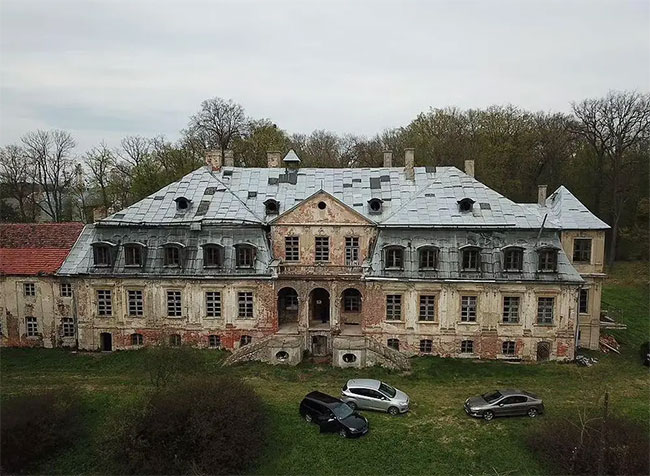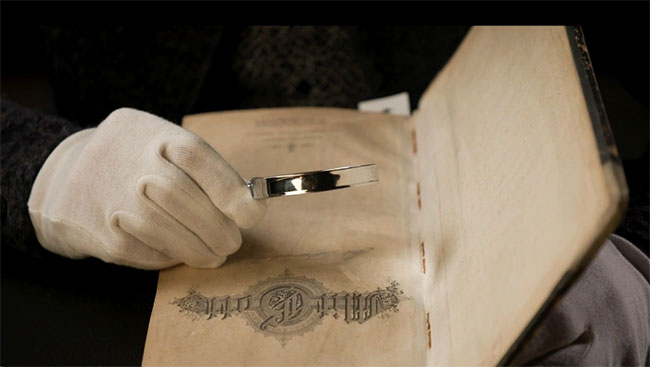Discovered an iron barrel containing 4 tons of gold: 'Treasure' that the Nazis hid
Recently, a search team called the Silesian Bridge Foundation reported that they had found four tons of gold that the Nazis had hidden. The search team said that they found the location of this gold thanks to information contained in the diary of a Nazi soldier and the help of modern machines such as ground-penetrating radar detectors.
The gold was hidden in a metal drum, buried in a palace in the Polish village of Minkowskie, more than 50km east of Wrocław. This palace has existed since the 18th century and was once used by Hitler's army as a brothel.

The palace where the golden box was found.
Silesian Bridge Foundation head Roman Furmaniak said: "…the shape and color [shown on the screen from the sensor's data] are quite unusual, suggesting that there has been human intervention underground. earth [.] Metal has a different density than soil, it will appear darker in the pictures shown."
He added that the location described in the barrel's diary and the actual location perfectly matched.
After receiving the signal from the radar, the search team asked permission from the relic protection agency to conduct exploration drilling. The results from the drills show that the land has human impact.

The diary is believed to be of a Nazi soldier, showing the location of the barrel.
Mr. Furmaniak said the first two drills proved that there was an abnormal disturbance in the ground, and the third drill hit something. Citing his words, he pointed out that there are some rocks that should not exist in such a geological area.
According to preliminary research, this gold was deposited at the Reichsbank (Wrocław, Poland), then stolen by Heinrich Himmler (a powerful Nazi figure) during the last months of World War II in order to establish a new Empire.

Geological exploration results show that there is a human impact.
The diary was sent to the search team about 10 years ago; The documents also point to 11 locations where World War II treasures were buried.
Minkowskie Palace was the first site the team looked for. According to the diary, large amounts of gold, artwork, valuables and religious artifacts were hidden in secret places throughout Lower Silesia (Poland) to avoid falling into the hands of the Soviet Red Army. .
The officer named in the diary, Michaelis, was said to have been the liaison between high-ranking Nazi officers and local nobles who wanted to help protect their possessions from the Soviet Union.
The search team claims that the diary belongs to a mysterious religious group known as the Quedlinburgers. The small town of Quedlinburg (Germany) is closely associated with Nazi worship in the 1930s and 1940s, due to its connection to the first German king Henry the Fowler in the 20th century. X. Furmaniak argues that the Quedlinburgers are descendants of Nazi officers who wanted to make up for Poland's losses caused by Nazi Germany during World War II. He said Quedlinburgers and the search team want any treasure found to be returned to its original owners.
The Silesian Bridge Foundation is waiting for permission to bring the crate to the surface. They are also waiting for permission from military commandos because the search team thinks this place may have traps set up by the Nazis.
- Gold jewelry set 2,500 years on the British field
- Discover the mysterious iron chest in the 'treasure city' of Canada
- The American farmer quit his job to find a treasure of 40 tons of gold and silver
- Treasure hidden at the bottom of the cup for more than 70 years
- China discovered a large treasure dating back more than 300 years
- Excavation, accidentally found the largest 1,400-year-old gold treasure in England
- Hopeless attempt to find treasure 500 tons of gold by King Solomon
- Detecting Viking gold treasure with metal detector
- Gold treasure excavation in Jerusalem
- Graves are yellowed in the sea floor
- The second treasure was discovered under the sea
- Treasure legend: Yamashita Gold Warehouse (Part 4)
 Discovered an ancient centipede fossil 99 million years old
Discovered an ancient centipede fossil 99 million years old Discovered bat-like dinosaurs in China
Discovered bat-like dinosaurs in China Discovered a 200-year-old bronze cannon of the coast
Discovered a 200-year-old bronze cannon of the coast Discover 305 million-year-old spider fossils
Discover 305 million-year-old spider fossils